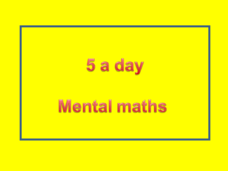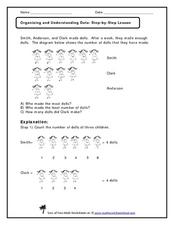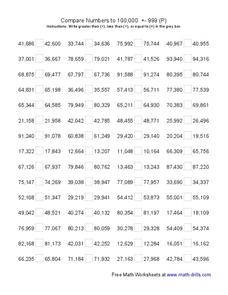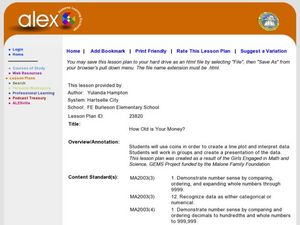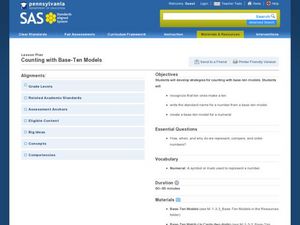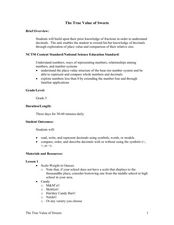Curated OER
Mass Lesson
It's not just a slideshow, it's a lesson on mass. First, learners complete a mental math warm-up, where they determine the number before and after a series of given numbers, then they form groups to weigh packages and compare mass....
Curated OER
Number Patterns
Which number comes next? The great part about this number sequencing worksheet is that it increases in difficulty so some learners who aren't challenged by the first few will definitely meet their match with the last couple. In each of...
Curated OER
Ordering to 20
Given a series of number lines, learners fill in missing number from 1-20 using the number pool provided. They add each number untill the number line is complete. This is a great activity to foster counting skills, number ordering, and...
Curated OER
Mental Math: 5 a Day
This is a really cool math resource! There are nineteen different slides containing five math problems each. They are intended to be used as daily math warm ups and address skills such as, addition, problem solving, missing addends, word...
Curated OER
Compare and Order Whole Numbers and Decimals
Here is a comparing and ordering worksheet in which learners read and solve six problems in which decimal and whole numbers are ordered and compared.
Curated OER
Organizing and Understanding, Step-by-Step
Use this number comparison and counting worksheet as an overhead projection for the whole class, because the answer is explained on the bottom half of the sheet. Cover the answer and reveal it once learners have tried it themselves. They...
Curated OER
Factor Pairs
This presentation covers a lot of ground. Square numbers, metal math computations, commutative property, ordering positive and negative integers, factoring, and real world problem solving are all covered. Use over the course of several...
Curated OER
Comparing and Ordering
Young mathematicians mark nine specific three-digit whole numbers on a number line. They compare/contrast 20 number expressions with one of the following signs: <, >, and/or =.
Curated OER
Compare Numbers to 100,000 (P)
Fourth and fifth graders write the greater than, less than or equal to symbol in a box between a pair of numbers.
Curated OER
Comparing Numbers
Young math whizzes compare forty-eight sets of numbers and write the correct sign, <, >, or = for each set of numbers in the box provided for each one.
Curated OER
Number Patterns
Spot the pattern! Pupils examine nine patterns using numbers 0-13. There are two blanks for learners to complete the pattern. None of these involve difficult math or complex concepts- this is for young pattern-finders. A bonus question...
Alabama Learning Exchange
How Old is Your Money?
Elementary learners explore coin mint dates. First, they listen to the book Alexander Who Used to be Rich Last Sunday by Judith Viorst. They then sort a collection of coins according to their mint date and put them in order from oldest...
Curated OER
Missing Numbers to Twenty
Which number is missing? Beginning counters examine twenty-six number sequences, one for each letter of the alphabet. Each sequence has four numbers, ranging from one to 20. There is one number missing from the sequence, and learners...
AGradeMath.com
Working With the 10,000 Chart
Calculate the answers to problems that are multiples of ten to help your class discern patterns in the zeros and learn to sequence. Each person receives a 10,000 chart, but s/he must discover that on their own through estimation and...
Curated OER
Where We Live
Who has the most? Young learners practice charting data using familiar information. They help fill out a classroom chart by recording the number of people, pets, televisions, etc. in their home. Guiding questions help them investigate...
Curated OER
Counting with Base - Ten Models
Help your kids develop strategies for counting. In this base-ten lesson, learners use matching cards, base 10 blocks, and dry erase markers and boards to examine the base 10 counting system.
Curated OER
The True Value of Sweets
Measure your pupil's learning in a lesson designed to explore decimals by weighing different candies on a scale and recording the weight. Small groups then compare and order the decimal weights on a number line to show their...
Curated OER
Generating Number Sequences
Practicing number sequences, students solve 5 various problems that include determining various number sequences in each. First, they work out what number comes out of each of the given machines. Then, students write down the first five...
Curated OER
Comparing and Ordering Fractions, Mixed Numbers, and Decimals
Create your own fraction kits by folding and labeling paper using fraction vocabulary. Learners then work in groups to use these in comparing and sequencing both whole numbers and fractions. They also create unit cubes and develop an...
Curated OER
Using >, < , and =
To practice comparing 2-digit numbers, learners evaluate 8 pairs of numbers and circle the appropriate symbol: greater than, less than, or equal to. Directions encourage use of "tens and ones." So break out the unit cubes and 10-rods to...
Curated OER
Lots of Lakes: Greater Than, Less Than
To set up this activity, your class explores Minnesota's nickname as the Land of 10,000 Lakes, and the back of the state quarter that features a Minnesota lake. Young mathematicians compare the number 1 to the number 10,000 with support...
Alabama Learning Exchange
Miss Integer Finds Her Properties in Order
Access prior knowledge to practice concepts like order of operations and exponents. Your class can play this game as a daily review or as a warm-up activity when needed. They work in groups of four to complete and correct review problems.
Curated OER
Count the Objects
Are there more apples or pears? Learners count images of familiar objects, and write the number below. Then, they color the object group with the most in number. There are four sets of objects to compare. Consider having students circle...
Curated OER
Describe the Pattern
In this math worksheet, students examine a series of numbers and determine the pattern. Students write the rule, then give the next numbers in the sequence. There are 15 problems to solve.





